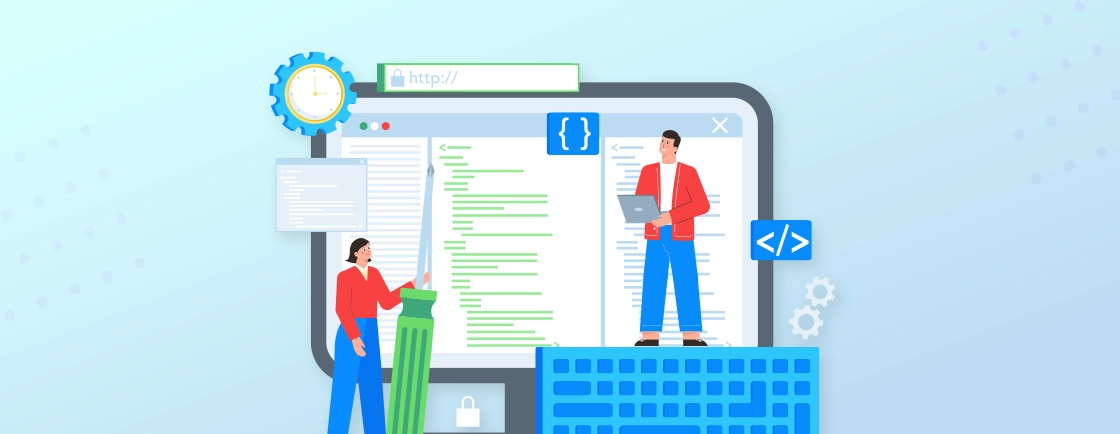Table of Contents
Here’s a scenario for you. One of your loyal clients has asked you to build a web application with the best PHP framework platform. But you don’t have the best PHP developers in your in-house team. But you don’t want to say no to the client. So how do you bridge that skill and resource gap in your team? Well, that’s where the IT staff augmentation services come in.
This hiring model helps you get the best experts for temporarily bridging the skills gaps and enhancing productivity. But there are some challenges with IT staff augmentation as well. Like, seamless integration in existing teams, maintaining data security, knowledge transfer, and more.
In this blog, we’ll talk about these challenges and how you can navigate through them with ease. Let’s begin.
Common IT Staff Augmentation Challenges
Like any other hiring model, the benefits of IT staff augmentation come with some challenges, both big and small. But you can navigate through them to ensure the best results.
However, you first need to understand the challenges in order to strategize correctly. So let’s take a look at the challenges one-by-one.
Challenge #1: Finding the Right Talent
The IT industry is evolving at a rapid pace with constant advancements in skill sets and technologies. So finding the right individual with expertise in the evolving landscape can be time-consuming and challenging.
Here’s why:
- Skill Mismatch: Identifying candidates with the exact technical proficiencies needed for the project can be difficult. A slight gap in skills can significantly impact project timelines and outcomes.
- Talent Scarcity: In high-demand tech niches, finding qualified candidates can be challenging due to limited availability.
- Cultural Fit: Ensuring that the augmented staff aligns with your company culture and work style is essential for seamless integration and productivity.
- Evaluation Process: Assessing candidates’ technical abilities and cultural fit can be time-consuming and resource-intensive.
Overcoming these hurdles requires a strategic approach, which we will cover next.
How to overcome this challenge?
Here’s how you navigate through this issue:
- Create detailed candidate profiles outlining the ideal candidate’s qualifications, soft skills, and cultural fit.
- Partner with top staff augmentation services to leverage the extensive networks and expertise. For example, WPWeb Infotech.
- Leverage employee testimonials and case studies to showcase your company as an employer of choice.
- Carefully evaluate developers’ qualifications and portfolios before engaging their services.
These tactics combined with a few others can help you find the right experts for your team.
Challenge #2: Coordination with Existing Team
Integrating new (albeit temporary) employees in your existing team can be a little tedious since there may be differences in work styles. Plus the effective communication strategies may be different, hindering the collaboration opportunities and impacting the project outcomes.
The root of the challenge is different backgrounds and work environments, resulting in unique perspectives and approaches.
Key issues that often arise include:
- Misaligned Work Styles: Different approaches to problem-solving, task prioritization, and communication can lead to misunderstandings and inefficiencies.
- Communication Breakdown: Effective communication is crucial for any team, but it can be particularly challenging when integrating remote or geographically dispersed staff.
- Cultural Differences: Variations in company culture, values, and expectations can create friction and impact team dynamics.
- Role Clarity: Defining clear roles and responsibilities for both existing and augmented staff is essential to prevent overlap and conflicts.
Addressing these challenges requires careful planning and effective communication between augmented and existing team members.
How to overcome this challenge?
Here’s how you foster a productive (and harmonious) work environment for augmented staff:
- Clearly define the roles and responsibilities of both existing and augmented team members.
- Create a detailed project plan outlining tasks, deadlines, and dependencies.
- Encourage open dialogue and feedback.
- Encourage social interactions to help team members get to know each other on a personal level.
- Educate augmented staff about the company culture, values, and expectations.
With a little time and effort, you can create a cohesive and high-performing team leveraging the strengths of both internal and augmented staff.
Challenge #3: Data Security Concerns
One of the common challenges with IT staff augmentation is safeguarding sensitive company data. Giving the external augmented staff the access to internal systems can increase the risk of data breaches, unauthorized access, and data loss.
Here are the key concerns related to data security:
- Access Control: Ensuring that augmented staff have only the necessary access to sensitive data is crucial. Improperly granted permissions can lead to data leaks.
- Data Encryption: Protecting data in transit and at rest is essential to prevent unauthorized access. Implementing strong encryption protocols is vital.
- Insider Threats: While not exclusive to staff augmentation services, the possibility of data theft or misuse by insiders increases with the introduction of new personnel.
- Third-party Risk: If the augmented staff is employed by a third-party vendor, assessing and managing the vendor’s security practices is essential.
Balancing the need for collaboration with the imperative to protect sensitive data is a critical challenge that organizations must address.
How to overcome this challenge?
Here’s how you navigate through this staff augmentation challenge:
- Implement strict access controls based on the principle of least privilege.
- Regularly review and update access permissions.
- Conduct comprehensive background checks on all augmented staff.
- Encrypt sensitive data both at rest and in transit.
- Emphasize the importance of data protection and the consequences of security breaches.
- Develop a comprehensive incident response plan to address data breaches effectively.
With these tactics and more, you can reduce the risk of data breaches and protect your organization’s sensitive information.
Challenge #4: Disordered Knowledge Transfer
When augmented IT staff leave a project, you have someone replace them. Then there may be a significant risk of knowledge loss. This can disrupt project continuity, hinder future decision-making, and increase the potential for errors.
Let’s look at the key challenges associated with that:
- Incomplete Documentation: Critical project information, system configurations, and best practices may not be adequately documented.
- Tacit Knowledge: Much of valuable knowledge is often unspoken or unwritten, making it difficult to capture and transfer.
- Time Constraints: Project deadlines can create pressure to prioritize deliverables over knowledge transfer, leading to incomplete knowledge sharing.
- Lack of Ownership: Responsibility for knowledge transfer may not be clearly defined, resulting in inconsistent efforts.
- Resistance to Share: Some team members may be reluctant to share their knowledge, fearing job security or increased workload.
Effective knowledge transfer is essential to ensure project sustainability.
How to overcome this challenge?
Here’s how you navigate through this staff augmentation challenge:
- Create a centralized repository for project documentation, including procedures, code, and decision logs.
- Create knowledge maps to visualize relationships between different knowledge areas.
- Involve both the departing and receiving teams in the planning process.
- Provide opportunities for shadowing experienced augmented staff to learn through observation.
- Utilize collaboration tools and platforms to facilitate knowledge sharing.
These tactics will help ensure there are no KT issues when the augmented staff is eventually replaced by a permanent employee.
Challenge #5: Standards & Practices
Maintaining consistent quality and adherence to organizational standards can be a significant challenge when working with augmented staff. Differences in work methodologies, tools, and processes can impact project outcomes and create inconsistencies.
Key issues leading to this challenge include:
- Inconsistent Quality: Variations in the quality of work delivered by augmented staff can affect the overall project outcome.
- Non-Adherence to Standards: Augmented staff may not be familiar with the organization’s coding standards, documentation guidelines, or security protocols.
- Tool Mismatch: Using different tools and technologies can hinder collaboration and create compatibility issues.
- Process Discrepancies: Variations in project management methodologies and workflows can lead to inefficiencies and delays.
- Risk Management Differences: Inconsistencies in risk assessment and mitigation strategies can expose the organization to unnecessary risks.
Navigating this challenge will help ensure project success and risk management.
How to overcome this challenge?
Here are a few strategies to handle this staffing augmentation challenge:
- Provide comprehensive onboarding for augmented staff, covering company culture, processes, tools, and standards.
- Implement rigorous quality assurance processes to ensure adherence to standards from both the augmented staff and existing team.
- Encourage the use of standardized software and applications.
- Create a centralized repository for project-related information, including best practices, templates, and guidelines.
- Establish clear performance metrics and KPIs to measure adherence to standards.
These tactics can help improve project quality and consistency.
If you need help navigating these challenges (even ensuring there aren’t issues in the first place), hire our staff augmentation company.
Best Practices with IT Staff Augmentation
IT staff augmentation can be a powerful tool for scaling your team and overcoming skill gaps. And you can make it even more successful with these best practices.
- Clearly Define Roles and Expectations: Outline the specific skills and responsibilities required for the augmented staff. Clearly communicate these expectations to both the internal team and the external resources.
- Choose the Right Augmentation Model: Determine whether you need full-time, part-time, or project-based augmentation. Consider factors such as project duration, skill set requirements, and budget.
- Select a Reliable Partner: If using a staffing agency, carefully evaluate their reputation, track record, and ability to deliver the required talent.
- Onboarding and Integration: Develop a comprehensive onboarding process for augmented staff. It will ensure they understand company culture, processes, and tools.
- Effective Communication: Establish clear communication channels and maintain open dialogue between the augmented staff and the core team.
- Performance Management: Set clear performance expectations and provide regular feedback to both internal and external team members.
- Data Security: Implement robust security measures to protect sensitive information. That includes background checks, access controls, and data encryption.
- Knowledge Transfer: Develop a knowledge transfer plan to capture and share critical information before augmented staff leave the project.
- Contractual Agreements: Clearly define the terms of the engagement. That includes intellectual property rights, confidentiality, and dispute resolution.
- Performance Evaluation: Regularly assess the performance of augmented staff and the overall effectiveness of the augmentation strategy.
- Feedback Mechanisms: Encourage open feedback from both internal and external team members to identify areas for improvement.
Following these practices effectively will help ensure a profound positive impact on your IT staff augmentation hiring.
Impact of Successful IT Staff Augmentation
A well-executed IT staff augmentation strategy can yield substantial benefits for your organization. Here’s a breakdown of the positive impacts:
- Accelerated Project Delivery: By bringing in specialized skills, augmented teams can expedite project timelines.
- Increased Focus on Core Competencies: Internal teams can concentrate on strategic initiatives while augmented staff handle specific tasks.
- Optimized Resource Allocation: Flexible staffing allows for efficient resource utilization based on project demands.
- Reduced Hiring Costs: Avoids the overhead associated with full-time employee recruitment, onboarding, and benefits.
- Optimized Labor Costs: Pay only for the specific skills and time required, eliminating the burden of idle resources.
- Rapid Scaling: Quickly increase or decrease team size to match project requirements.
- Adaptability: Respond to market changes and evolving business needs with agility.
- Innovation Catalyst: Introduce fresh perspectives and innovative approaches to problem-solving.
- Reduced Overburden: Alleviate the workload of existing internal team, preventing burnout.
To Summarize
The IT staff augmentation model is excellent for addressing skill gaps, enhancing productivity, and accelerating project delivery. But of course, there are some challenges, including finding the right talent, integrating augmented employees with an existing team member, ensuring data security, etc.
But you can ensure the best results with detailed job requirements, clear communication channels, robust security measures, and more. And remember, careful planning, effective execution, and ongoing evaluation can make the hiring even more successful.
If you need help augmenting your staff with additional skills and expertise, connect with us, a leading IT Staff Augmentation company.
FAQs on IT Staff Augmentation Challenges
Is IT staff augmentation cost-effective?
It can be cost-effective as it avoids hiring and training costs, but it depends on factors like project duration and complexity.
How can I measure the ROI of IT staff augmentation?
Track key performance indicators (KPIs) such as project timelines, cost savings, and quality improvements.
How can I ensure the cultural fit of augmented staff with my organization?
Clearly communicate company culture during the recruitment process and conduct cultural assessments.
Explore Our Expert Guides
Dive into detailed tutorials, tips, and strategies designed to help you grow, innovate, and solve problems efficiently.





